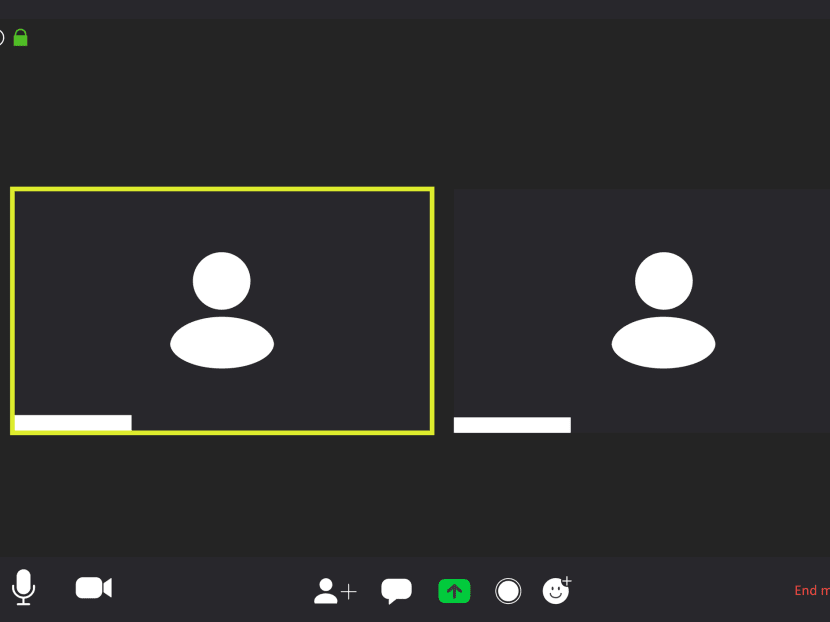Commentary: Should bosses force their employees to turn on Zoom cameras?
In the absence of critical face-to-face interactions, meetings have gone online and the simple act of whether your video is on or off does make a difference, says SUSS’s Victor Seah.

(Photo: iStock)
SINGAPORE: My wife, who works in finance, was scheduled for a workplace training in November last year and only after logging in did she find out that her camera had to be switched on throughout the Zoom training sessions with virtual backgrounds disabled.
We scrambled to make the study room look less like a pigsty by draping cloth over piles of books and loose papers. We moved old electronics gathering dust out of sight. We fengshui-ed the laptop to find the perfect angle.
While the merits of switching on your camera for Zoom calls is debatable, there does not seem to be any good reason to forbid employees from using a virtual background. The argument that this prevents people from using a recording of themselves as a virtual background to pretend that they are attending the meeting is problematic for at least two reasons.
It suggests a deeper trust issue and there are simpler and more logical solutions such as engaging your attendees.
Engaging your attendees should be the focus of Zoom calls, not whether or not their cameras are switched on. As someone who has hosted a virtual symposium without seeing another attendee, despite a purported 300-plus attendees, I appreciate the value of cameras being switched on. Yet, there are multiple reasons why leaders should not force employees to have their cameras switched on.
SWITCHING ON THE CAMERA MAY NOT BE SO SIMPLE
Employees with children at home, and/or with inadequate home working places find it challenging to switch on their cameras. No one wants their family appearing in their work meetings.
And beyond a few cameos of cute children and household pets, the appearances of a topless uncle walking by the camera are distracting for everyone and stressful to the employee.
Forcing employees to switch on their cameras can also be counterproductive for a variety of reasons. In human psychology, motivations are either extrinsic or intrinsic – doing something because you must versus wanting to.
In this case, when it is extrinsic, psychological reactance may occur, and employees’ sense of control can be reduced.
A camera-on policy may lead to a shift from intrinsic to extrinsic motivation. By forcing employees to switch on their cameras, their motivation becomes externalised, or extrinsic – following company policy (and threats).
This diminishes any intrinsic motivation such as “doing the right thing” or “wanting to present ourselves to our co-workers”. While extrinsic motivation (like sales commission) has its place in organisations, intrinsic motivation has been connected to a whole suite of positive work outcomes such as prosocial behaviours at work, stronger identification with the organisations, and greater creativity.
Leaders should strive to cultivate employee intrinsic motivation. One way to do so is to refrain from unnecessarily imposing extrinsic constraints.

Psychological reactions can occur when we sense an attack on our autonomy and correspondingly, we respond to regain our freedom. In this case, a camera-on policy may be viewed as a threat to autonomy.
In turn, employees may engage in freedom-restoration behaviours such as taking long post-meeting breaks or multitasking during Zoom meetings. A camera-on policy may work against our goal of having engaged Zoom call attendees.
SMALL THINGS CAN ADD UP
In many ways, COVID-19 has robbed us of our sense of control - we had to adapt to changing restrictions and now we must abide by social restrictions even as we head back to the physical office.
But because some teams will inevitably be home and others in an office, Zoom meetings are here to stay. Most leaders have good intentions and there are good reasons to ask employees to turn on their cameras.
A camera-on policy is likely intended to increase employee participation, productivity, and camaraderie. This belief is a digital continuation of our misuse of meetings. Meetings, virtual or physical, routinely top surveys asking for biggest bugbears at work.
Research has gone into how to conduct better meetings. One key step is to not try to do too much. A meeting, especially virtual ones, is not a suitable medium to build camaraderie.
A 2020 study with more than 3 million respondents found that while the number of work meetings have increased during the pandemic, meetings have become more formal and shorter in duration.
This means that there are even fewer opportunities for that water-cooler talk that can aid in team building. Leaders should know that virtual meetings, with or without cameras switch on, is not an effective team building medium. Insisting on a camera-on policy may not meet this objective.
Related:
FINDING A GOOD BALANCE
What about employees? Employees are advised to switch on their cameras where possible. Firstly, what leaders implicitly or explicitly intended when wanting cameras switched on –makes for better communication.
A 2020 study among knowledge workers found that the third most cited reason for reduced productivity working from home was difficulty in communicating with co-workers. That’s not surprising since non-verbal communication, such as facial expressions and body language, accounts for more than 50 per cent of the information conveyed in face-to-face communication.
While studies have found that non-verbal communication in virtual meetings is inferior to face-to-face meetings, it is a vast improvement compared to talking to a black box or an inanimate picture.
Secondly, there’s the mere exposure effect. More than 200 studies have found support for our tendency to like something simply by being exposed to it repeatedly without negative outcomes. Familiar faces at work are going to be more preferred to their unfamiliar, yet otherwise identical, colleagues.
Finally, switching on your camera and being seen reduces the psychological distance (the perceived difference) between you and your co-workers. Being seen during Zoom calls help ease the transition back to the office.
An effect of losing all that water-cooler talk during WFH is an increase in psychological distance. If you want that eventual water-cooler conversation to be less awkward, switching on your camera so everyone can see each other, can help bridge the transition to being back in the office.
Dr Victor Seah is Deputy Head, Psychology Programme, School of Humanities and Behavioural Sciences at the Singapore University of Social Sciences.







